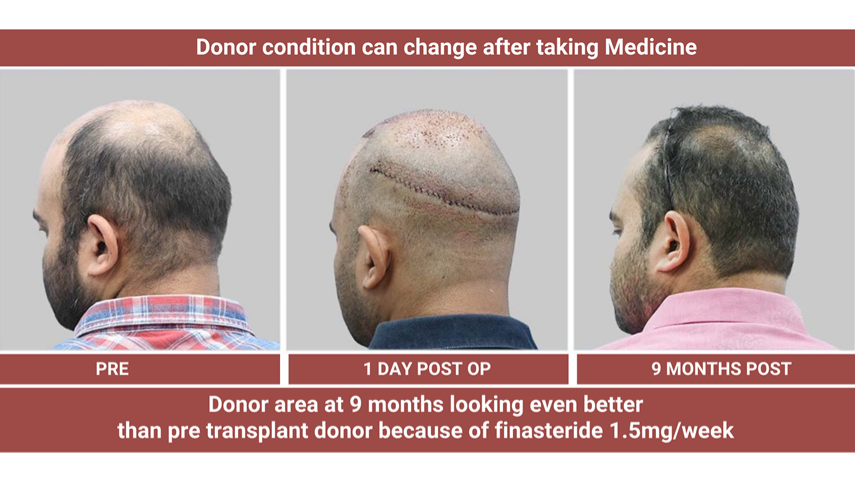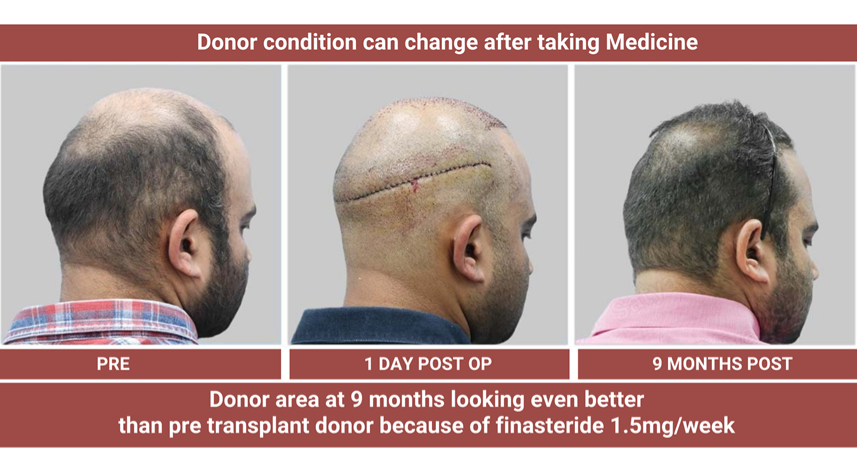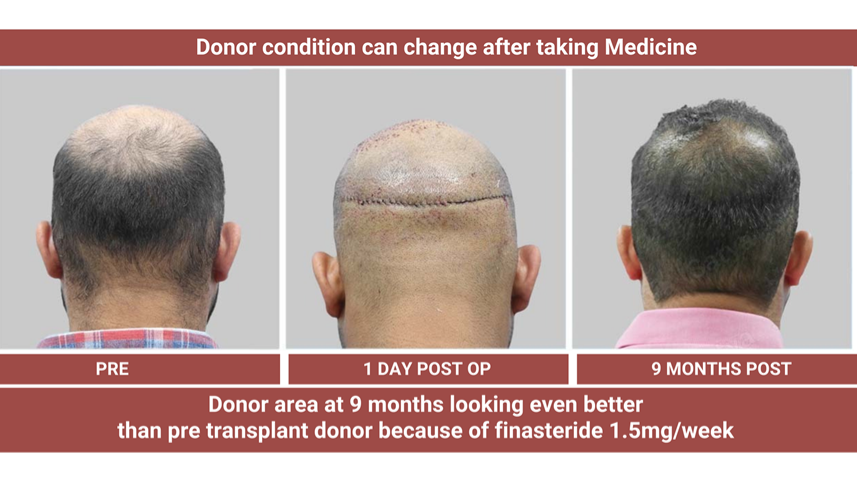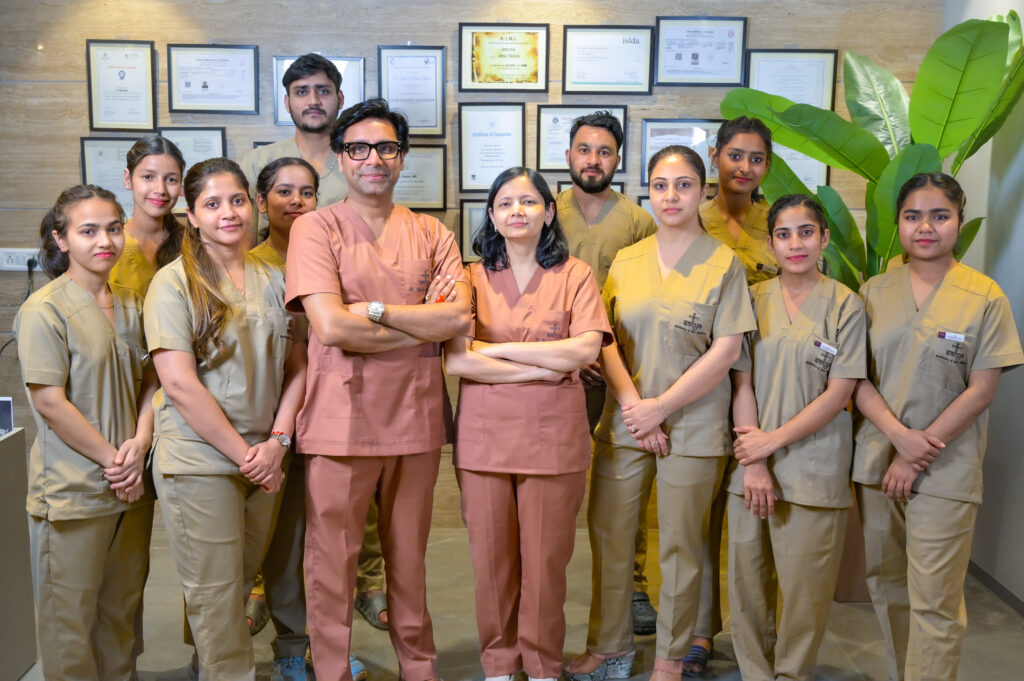
Medicine First or Transplant First? The Right Approach to Hair Restoration
One of the most often asked questions by patients thinking about hair restoration is whether they should begin with medication or go straight to a hair transplant. Sadly, many clinics mislead patients into first “improving” the donor location before surgery by guiding them into full-dosage pharmaceutical intake. Although at first, this seems reasonable, it is a very immoral and faulty strategy that usually leaves one disappointed, with obvious scars and wasted money.
Founder and Chief Hair Transplant Surgeon Dr. Shail Gupta at Satya Skin & Hair Solutions, explains why beginning with medication before a transplant can be detrimental and stresses the ethical, patient-first approach to get natural, long-lasting outcomes.
The Myth of “Medication First to Improve the Donor Area”
What happens when first given medication?
Medications like finasteride or minoxidil used before a hair transplant can give the impression of better donor density. Here is what occurs:
- Temporary Illusion:
- The medication stimulates hair growth in the donor area, turning a poor donor area into what appears to be a great one.
- These improvements are temporary and dependent on continued medication.
- Risk of Permanent Damage:
- The hair “thickened” by medication is not permanent and will vanish if the medication is stopped or loses effectiveness due to tolerance.
- Grafts harvested from such areas are weak and unsuitable, leading to:
- Poor growth in the recipient area.
- Visible scarring in the already weak donor area.
- Patient Exploitation:
- Clinics often prioritize short-term financial gains by convincing patients to undergo surgery inappropriately, leading to wasted money, unnecessary pain, and unsatisfactory results.



Why This Practice Is Dangerous
1. Unsafe Donor Harvesting
Hair transplanted from areas improved temporarily by medication won’t survive long-term, resulting in poor outcomes.
The donor area, already weak, suffers unnecessary scarring that cannot be reversed.
2. Over-reliance on Medications
Patients are often kept on full doses of medication indefinitely, exposing them to unnecessary health risks without sustainable results.
3. Loss of Transition Areas in the Recipient Site
When the transplant is done after medications, the placement of grafts is compromised.
Key transition areas, which are critical for achieving a natural look, may be neglected or unattended.
The Right Approach: Transplant First, Then Medication
At Satya Skin & Hair Solutions, we advocate for a balanced and ethical approach to hair restoration:
1. Transplant First to Maximize Donor Potential
Performing the transplant before starting medication allows the surgeon to harvest the best possible grafts from the donor area.
The natural, unaffected hair is used, ensuring:
Strong, healthy grafts.
Optimal long-term survival.
2. Strategic Placement in the Recipient Area
Grafts are placed in the recipient site with precision, focusing on natural-looking transition zones and maximizing overall density.
This ensures that the results are relatively more sustainable, even if medications are discontinued later.
3. Customized Medication Plans
After the transplant, medications may be introduced in micro-doses if necessary, tailored to the patient’s specific needs and goals.
For patients with progressive hair loss, this approach allows for:
Gradual improvement.
Reduced risk of tolerance.
Minimal side effects.
Who Can Avoid Medications Altogether?
In some cases, patients may not need medications at all:
- Patients with Stable Hair Loss:Individuals with minimal or slow-progressing hair loss may achieve excellent results without medication.
- Female Patients:Women, who typically experience diffuse thinning rather than patterned baldness, often benefit more from transplants than from medications.
The Exceptions!
It is finally at the discretion of the surgeon & the needs of the patient. In some cases, patients need medications before the transplant:
- Patients with Very Aggressive Hair Loss: Individuals with excessive or aggressive hair loss need medication first to slow down the progression of the disease.
- Patients with Minimal Hair Loss: Individuals with minimal hair loss can recover with medical treatments & PRP. In such cases transplant is not the 1st option.
The Satya Difference: Ethical and Customized Care
At Satya, we reject unethical practices and prioritize patient health and long-term success:
1. Expert Transplant Techniques
We offer FUT, FUE, and combination procedures, ensuring the best technique is chosen for each patient.
2. Micro-dosing and Customization
Medications are prescribed only when necessary, starting with minimal doses to avoid risks and dependency.
3. Transparent Consultations
Patients are educated about the risks of medication-first approaches and the importance of sustainable planning.
A Word from Dr. Shail Gupta
“Hair restoration is not about quick fixes or temporary solutions. At Satya, we believe in achieving results that last a lifetime by prioritizing patient health, skillful transplants, and ethical use of medications. A transplant done with integrity is always better than one compromised by temporary illusions created by medication.”
At Satya Skin & Hair Solutions, we ensure every patient receives an ethical, customized plan for sustainable and natural results.
🔗 Contact us today to learn more about our ethical hair restoration practices.
Choose transparency. Choose Satya.
Look good for sometime vs lifetime

Know the secrets of long lasting results
Read Some of our important Blogs

Why Choose Satya?
20+ Years of Expertise – Renowned in dermatology and hair restoration with a legacy of excellence.
Globally Accredited – Affiliated with the American Academy of Aesthetic Medicine.
Tailored Treatments – Personalized care crafted to suit your unique needs.
World-Class Facilities – State-of-the-art laser and surgical technology. –
Specialists in Corrective Treatments – Experts in resolving unsatisfactory results from other clinics.
265,000+ Satisfied Patients – Trusted worldwide for successful outcomes and client satisfaction.
Comprehensive Care – From skin lasers to advanced hair restoration under one roof.
Ethical & Patient-Centric – Transparency and patient well-being are our priorities.
What Our Patients Are Saying






Frequently Asked Questions
Starting with a hair transplant ensures the quality of donor hair. Medications can be added later, should maintenance call for them.
Many clinics promote medications to artificially increase the donor area, which results in short-term effects and maybe long-term damage.
Medications can give the impression of a healthy donor location, but grafts taken from such places would not survive long-term and produce inadequate results.
Medications like finasteride and minoxidil can reduce hair loss and increase density; they cannot permanently replace lost hair.
After a transplant, some patients—especially those with steady hair loss or little thinning—may not need medications.
Starting with a transplant ensures strong grafts and sustainable results by allowing the use of natural, unaffected donor hair.
After a transplant, some patients—especially those with steady hair loss or little thinning—may not need medications.
Micro-dosing is the use of low doses of medications to preserve effectiveness while lowering side effects and reliance.
Medication before a transplant helps patients with early-stage or aggressive hair loss stabilize their condition.
Most of the time, women’s diffuse thinning can be corrected with transplants rather than medicine.
Though the effects are temporary, finasteride might momentarily thicken donor hair, giving the impression of health.
Take Our Quick
Hair Loss Quiz
Find out the best treatment for your
hair loss today





